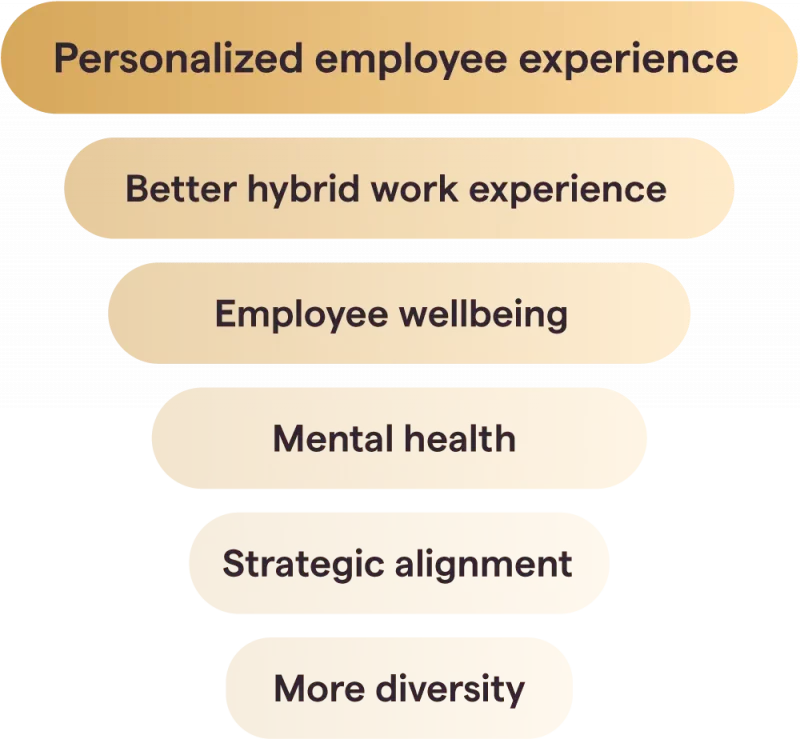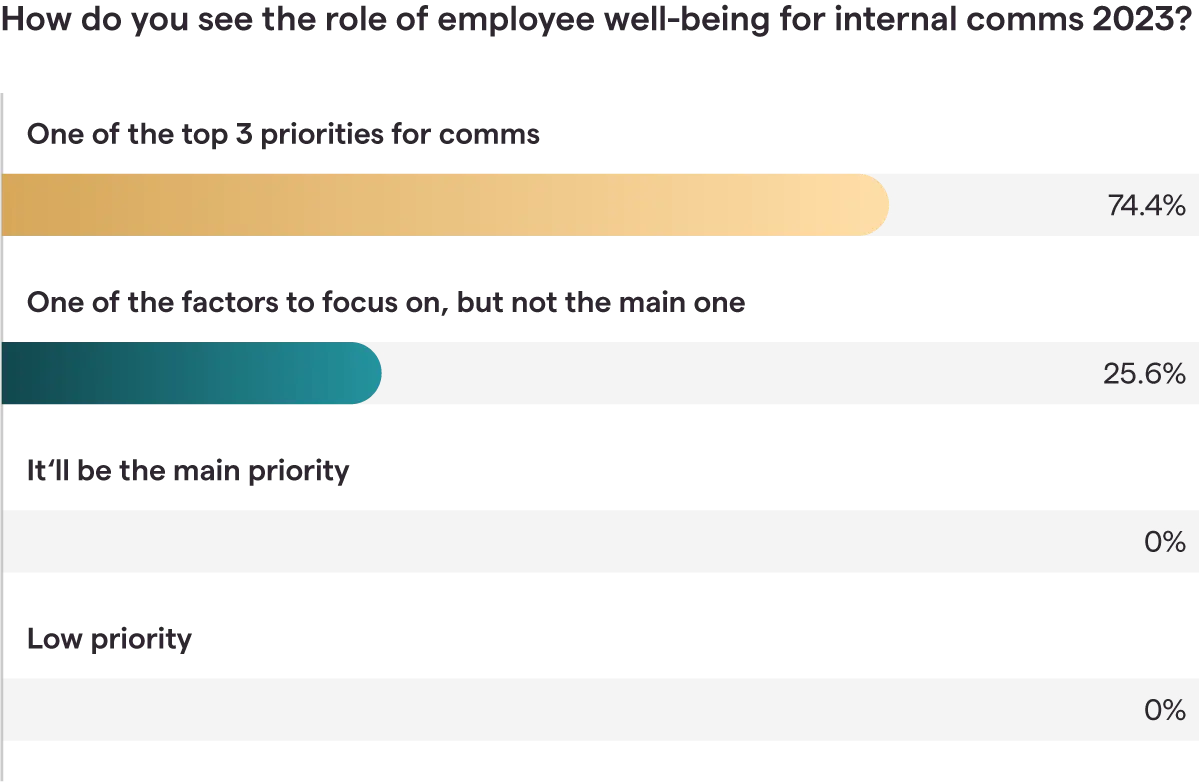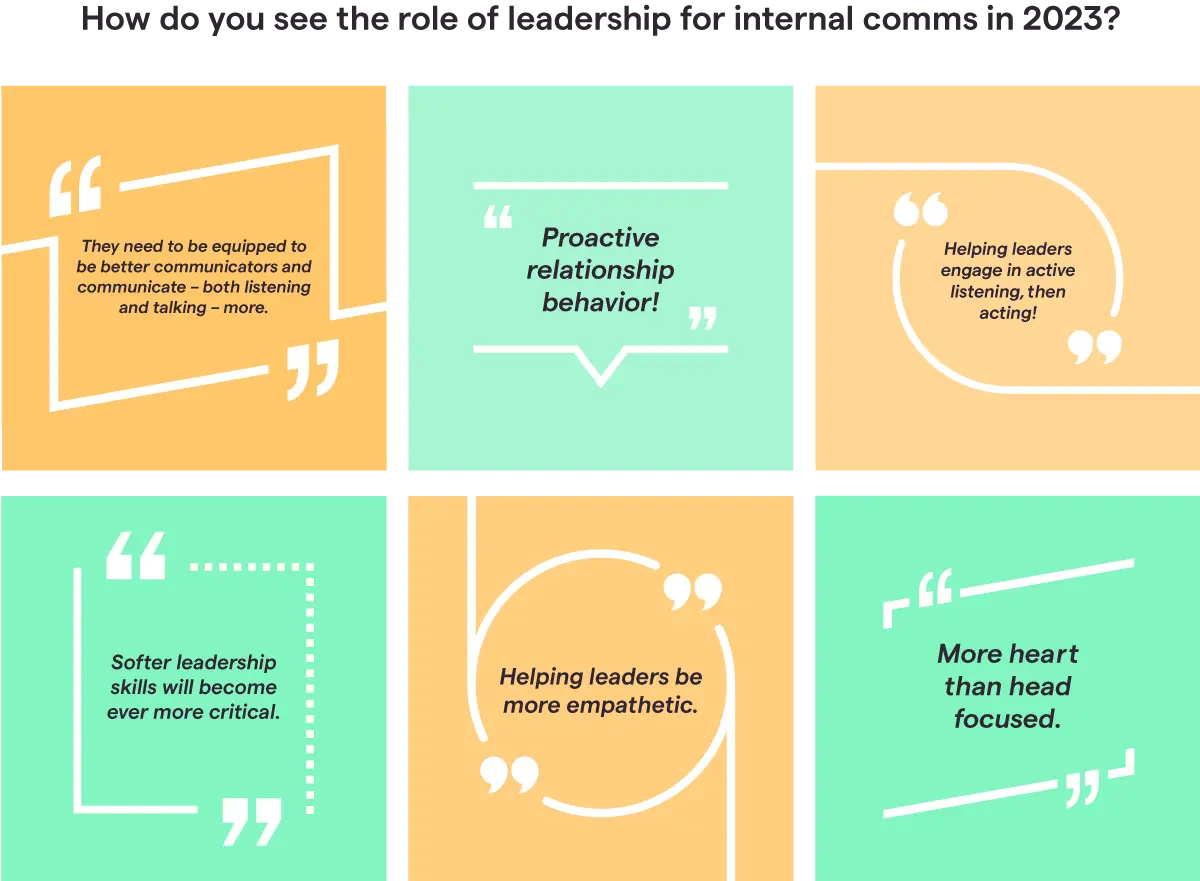Internal communications trends in 2023
a Haiilo Research Report by Brad Whitworth
The future of internal communications is rarely the fulfillment of a single person’s vision. Nor is it ever a straight-line projection of the past and the present. It never comes from reading tarot cards, Ouija boards, fortune cookies or a Magic 8 Ball. Rather, the future takes shape at the epicenter of trends, creativity, needs, technology and experience. It takes root in the collective efforts of internal communication (IC) professionals from every industry in all parts of the world.

Our methodology
To scan the horizon and explore what’s ahead for IC professionals, Haiilo turned to the people who are on the edge of the wedge. We surveyed more than 50 IC thought leaders from around the globe to get their perspectives. We polled the best and brightest communicators who have both the ability to see around corners and know how to use those insights to shape the future. We’ve captured their responses – both quantitative and qualitative – in this report. We loved what they said … and we really appreciated the deeply thoughtful and sometimes surprising responses. We hope the diversity of ideas and perspectives presented here helps you build a brighter future for your employees.
– Brad Whitworth, SCMP, IABC Fellow
Senior Advisor, Haiilo Strategic Services
1. Tracking internal communication trends
If there has been a silver lining to the global pandemic of the past few years, it’s that internal communications became an absolutely crucial function in nearly every organization around the world. Senior executives came to rely on their IC teams to keep in touch with their workforces at a time when nearly every workplace went virtual.
When asked to identify what trends were likely to continue to impact the IC function through 2023 and beyond, the thought leaders put two related topics at the very top of their lists:
- Increased concern for the individual employee experience
- Improved hybrid work models
These two trends will help IC professionals focus on creating the new internal communications environment for the future.


We have to understand the technology tools that will enable us to segment and reach our audiences as well as listen, understand and engage with them.
2. Enhancing employee wellbeing, near and far
Employees have been through a lot during the past few years. And for far too long, employers haven’t paid attention to their people who show up day-in and day-out. It’s time to make sure that current employees’ physical and mental needs are being met, that they are receiving recognition and praise for their efforts, and that they are being compensated fairly. Where that’s not happening, employees are packing up and leaving in droves as part of the “great resignation” or disengaging from work through what’s being called “quiet quitting.”
The information needs of the veteran employees who have survived a rough couple of years are radically different from the needs of tomorrow’s new hires. The communication that you’ll be crafting for employees who are returning to downtown offices will need to be re-imagined for employees who are choosing to work remotely.

The bottom line:
Communicators will need to tune their IC programs to meet the varying information needs of their employee audiences. That’s plural: audiences. The future is going to require moving away from one-size-fits-all IC channels and messages and moving toward focused communication efforts for segments of employees. IC professionals will need to embrace decentralized communication models that are receiver-centric rather than sender-driven.
Moreover, employees themselves will exert more control over which messages they need to see every day to be effective in their jobs. A nurse in a hospital’s neo-natal department will need radically different corporate communications – content and channels – than a pharmacist working just two floors away in the same facility. They’ve always had the capability by simply deleting or ignoring messages that are irrelevant to them. IC professionals will build models in the future that allow employees to subscribe to the information they really want and need.

You’ve got a lot of people focused on the human aspect of communication because we’ve been virtual for such a long time now. Internal communications is really all about creating those human connections because we realize how important they are.
3. Managing change
For far too long, IC professionals were charged with merely reporting about change efforts underway in their organizations – anything from the launch of a new payroll system to a corporate restructuring. And often those communication efforts were last-minute, ill-considered or created by people who are not communicators. They’re written to please the leaders implementing the change rather than focusing on the information needs of the employees who are affected by the change.
Today’s communicators are no longer reporters working from the sidelines. They’re active participants in effecting change by baking effective communications into every change-management program from the start. They’re helping drive change instead of merely describing its progress.
71.8% agree that change management and change communication will play a significant role in communications strategy in 2023.
Internal comms thought leaders told us that the most effective change-management communication involves everyone from the senior-most leader in the organization to individual supervisors – not merely project team leaders. While project leaders have high credibility, they often are unable to see change through the eyes of the employees who are most directly impacted. That’s why they must partner with IC pros in the future.

Making certain that our employees have the ‘shock absorbers’ to handle anything that happens on a given day is an important aspect of managing change.
4. Driving employee engagement
Can you prove to your senior management team that the internal communications function makes a difference? If not, now is the time to start. Research has proven that effective internal communications can motivate 85 percent of employees to be more engaged in the workplace.
More than 43% of those surveyed said that there’ll be a shift towards more engagement-oriented metrics in 2023.
Do you ask employees questions focused on engagement in your organization’s annual or quarterly survey? Or in more-spontaneous pulse surveys? Do you monitor what employees are saying on internal chat platforms? Are in-office employees concerned about the same issues as remote workers? Do you look at what your current workforce is saying about the company on external platforms like Vault and Glassdoor? Are you tying your communication objectives (and metrics) to corporate goals?

Because now we have a hybrid future, that means we’ll need new technologies.
You want to learn more about your metrics?
5. Building leadership skills
The last couple of years have challenged senior execs with issues that many could never have imagined: a global pandemic, supply-chain shortages, war, climate change, remote working, the “great resignation,” and more. Nothing in business school or prior jobs prepared today’s leaders for the tsunami of turmoil that has impacted their customers, their industries and their own employees.
In this fast-changing world of crises, the best leaders devoted more attention to their workforces. They engaged in active listening and then acted. Perhaps because they were affected just like their employees, most of them showed their human side – including their flaws – sometimes for the first time. They met remotely with their employees and spoke from their hearts instead of from PowerPoint decks. And, perhaps most importantly, they partnered much more closely with their IC teams.

The respondents to our survey feel this trend will continue. As one of our IC thought leaders said, “Leaders who are active and purposeful in their communications … will obtain the greatest results in any type of environment.”

Managerial communication will retain its importance in the future, but listening, monitoring and engaging on-line are needed to complement the long-prioritized IC role.
6. Navigating economic Impacts
The COVID pandemic spawned an economic meltdown around the globe. Some industries – hospitality and tourism, for example – were devastated. Offices and factories were closed. Healthcare systems were overwhelmed. Office employees started working from home and central business districts became ghost towns.
If there was an upside to the impact of COVID, it was that employers quickly discovered that remote working didn’t hamper productivity. Rather, many companies reported increases in productivity and engagement.
At the same time, many employees looked hard at their work-life balance and decided that they were tired of long commutes, crowded office buildings, job burnout, and time away from home and family. One of the byproducts was “the great resignation” where companies saw significantly higher turnover rates than before coupled with difficulty recruiting replacements.
20.5% agree with the statement “I expect the current economic situation to affect the comms budget and strategy in 2023.
When asked if these macro-economic changes would impact communication budgets, programs and strategies in 2023, one-fifth of the respondents said “yes.” While there will certainly be companies that try to shrink internal communication budgets, the most savvy communication leaders will use lessons learned during the past few years to prove that investments in communication, platforms and technology can result in increased productivity and employee engagement.

How many times do we get an opportunity to really, truly change things after a global cataclysmic event?
Conclusion
No one can say with any certainty what the future holds. The internal communication profession has the opportunity to help shape the future proactively rather than merely waiting and reacting to what comes.
Now is the time to act boldly. The new ways to work require new approaches to communication. Use metrics to make the case for needed changes to your communication program. Address the future needs of your workforce who have adapted to a world now defined by a mix of face-to-face, virtual, on-line, recorded and streaming communications. Abandon top-down-driven, sender-centric communication models. Move away from all-employee emails and meetings. Let your employees determine what information and communication tools they need to do their jobs efficiently and productively. And find ways to involve everyone … from senior leaders to rank-and-file employees as contributors to the communication process.


Change before you have to. The worst mistake is to do the right thing for too long.


